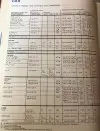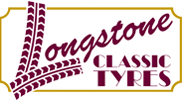Jensen Interceptor Tire Pressures
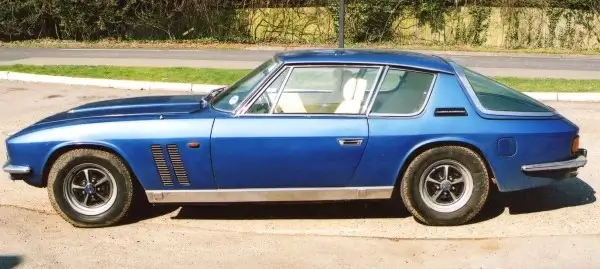
1969 Jensen FF MKI
To buy tires for your Jensen Interceptor see our Jensen Interceptor Tires page.
- The Longstone recommended tire pressures for either Jensen Interceptor on crossply tires are 32/32 PSI, and on radial tires we suggest 36/40 PSI.
- According to historic fitment guides; tire pressure for a Jensen Interceptor ranges from 24-48 PSI depending on the specific model, the type of tires that you decide to fit, and pressure differences for front and rear tires.
- To find the ideal tire pressures for your car's year, model, and chosen tires follow the link to our Tire Pressure Guide.
- If you desire crossply tires for the 1950s Interceptor we recommend fitting the 6.00-16 PIRELLI STELLA BIANCA, or the 185 VR 16 PIRELLI CINTURATO CA67 if you want radial tires.
- For the 1966-76 Interceptor we recommend the 185 VR 15 PIRELLI CINTURATO CA67, the 205/70 R 15 PIRELLI CINTURATO CN12 or the 215/70 WR 15 PIRELLI CINTURATO CN12 depending on your year and model.
- To find out more information on Jensen Interceptor tires follow the link to our Jensen Interceptor Tire Section.
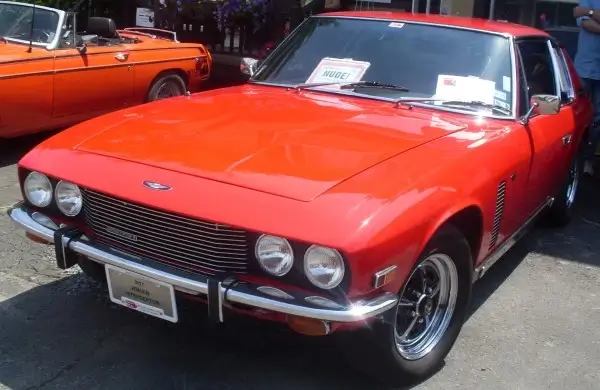
1971 Jensen Interceptor
Recommended Tire pressures for a Jensen Interceptor
Below we have a list of Tire Fitment Guides for the Jensen Interceptor from Michelin, Pirelli, and Dunlop. However, the older fitment guides may not reflect the advancements in tire compounds and road speeds. Therefore, we've provided our own updated tire pressure recommendations for contemporary classic tires in a single table. With the improvement in tire quality from top manufacturers, you can safely use higher pressures. It's important to avoid under-inflation, as this can lead to a blowout. We've taken the higher pressure, high-speed recommendations from these outdated fitment guides to ensure your safety on the road.
| Tire | Front Tire Pressure (PSI/BAR) | Back Tire Pressure (PSI/BAR) |
|---|---|---|
| 6.00-16 PIRELLI STELLA BIANCA | 32 / 2.2 | 32 / 2.2 |
| 185 VR 16 PIRELLI CINTURATO CA67 | 36 / 2.5 | 40 / 2.8 |
| 185 VR 15 PIRELLI CINTURATO CA67 | 36 / 2.5 | 40 / 2.8 |
| 205/70 R 15 PIRELLI CINTURATO CN12 | 36 / 2.5 | 40 / 2.8 |
| 215/70 WR 15 PIRELLI CINTURATO CN12 | 36 / 2.5 | 40 / 2.8 |
Jensen Interceptor (1950–1957) Tires
The first Jensen Interceptor, produced from 1950 to 1957, was equipped with 600-16 crossply tires. If you prefer this type of tire, we recommend the Pirelli Stella Bianca 6.00-16. However, for improved handling and stability, we recommend upgrading to 185-16 radial tires, such as the Pirelli Cinturato CA67. The Michelin 16F innertube is the best choice for these tires.
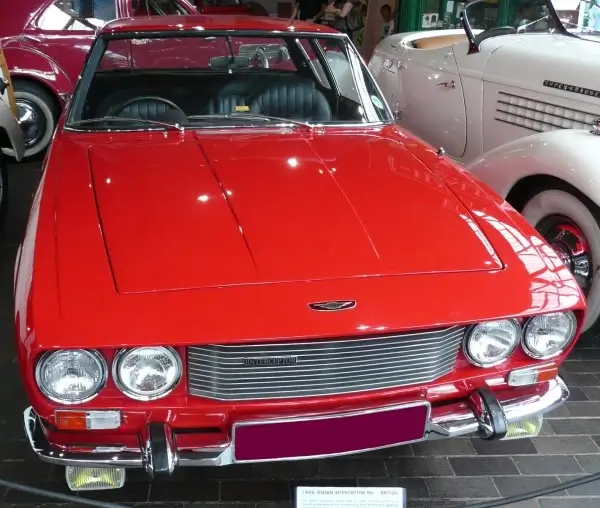
1969 Jensen Interceptor MKI
Jensen Interceptor (1966–1976) Tires
The Jensen Interceptor from 1966 was initially equipped with 670-15 Dunlop RS5 tires, which are no longer manufactured. If you prefer crossply tires, we recommend the Avon Turbospeed 670 H 15. However, we believe that a car like the Interceptor deserves the finest tire technology available. Therefore, we suggest installing 185 VR 15 Pirelli Cinturato CA67 radial tires, which will make the Interceptor much more suitable for today's high-speed highways.
Jensen Interceptors from 1970 were equipped with ER/70 VR 15 Dunlop SP Sport Aquajet tires. In 1971, Jensen began using 205/70 R 15 Pirelli Cinturato CN12 tires. The Michelin 15F innertube is the suitable size for these tires.
Some later Interceptor Series 3, FF, and R versions had 215/70 WR 15 Pirelli Cinturato CN12 tires. The Michelin 15/17H innertube is the best match for these tires.
We propose the Pirelli Cinturato ™ CN12 or the Michelin XWX for all later Jensen Interceptors, as they are W speed-rated, era correct, and made by the world's leading tire manufacturers.
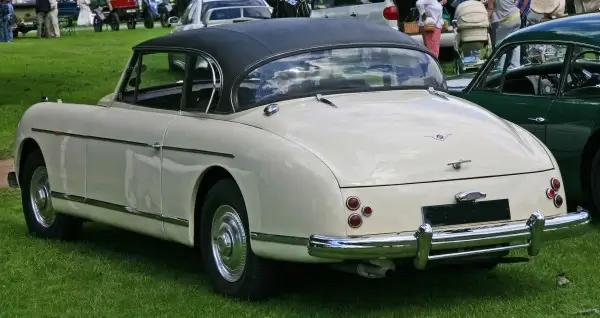
Early Jensen Interceptor Rear
History of the Jensen Interceptor (1950–1957)
Jensen Motors introduced the Jensen Interceptor in 1950, as the company's second vehicle following World War II. The car was built using Austin components, with a Jensen body and styling by Eric Neale. It featured a 4L straight-six engine and gearbox from the Austin Shearline, and the chassis was an extended version of the Austin A70's with a revised independent coil-sprung suspension.
The two-door Interceptor was first released as a convertible, with an aluminum and steel body on a wood frame. To access the engine, the entire front piece could be swung forward. The wraparound back window was made of Perspex and could fold down into a storage compartment. In 1952, a hardtop variant with a fabric-covered roof was introduced, as well as a few sedan models. A total of 32 convertibles, 52 saloons, and four sedans were built.
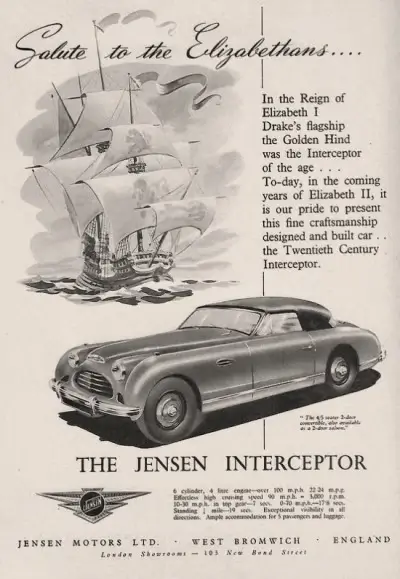
Early Jensen Interceptor Advert
Initially, the brakes used a combined Girling hydraulic and mechanical system, which was later replaced with a 100% hydraulic system. In 1952, the four-speed manual gearbox acquired an optional overdrive feature. When this was installed, the rear axle gearing was reduced to 3.77:1. A convertible tested by The Motor in 1952 had a maximum speed of 95 mph and a 0-60 mph time of 17.8 seconds. The fuel efficiency was 20.3 miles per imperial gallon.
Briggs Cunningham, an American race car hero, had a left-hand drive Interceptor built in 1953 with a 5.4L, 180 horsepower Chrysler "Firepower" hemi engine. With a top speed of around 145 mph, it was the second-fastest production vehicle in 1955, after only the Mercedes Benz 300SL. Unfortunately, only 88 of the early Interceptor cars were made before production was halted.

Jensen Interceptor MKIII Blue
History of the Jensen Interceptor (1966-76)
Jensen Motors crafted the Jensen Interceptor at its Kelvin Way Factory in West Bromwich, England between 1966 and 1976. The Interceptor name had been used previously by Jensen for a different model produced between 1950 and 1957. Unlike earlier models, the new Interceptor featured a steel body shell instead of glass-reinforced plastic. The body design was created by Carrozzeria Touring of Italy, an outside firm, rather than by Jensen's in-house design team. Early bodies were built in Italy by Vignale before Jensen took over manufacturing and made slight modifications to the body design.
Starting in 1969, Jensen Motors began installing Chrysler V8 engines in the Interceptor, beginning with the 6,276 cc engine. Customers could choose between a manual or automatic gearbox. In 1970, the engine generated 335 horsepower SAE gross (tested on a stand under ideal conditions). In 1971, Jensen upgraded to a 7,200 cc Chrysler engine with two options: one with a 4-barrel carburettor producing 305 horsepower SAE net (based on the engine's performance inside the car under normal conditions) and the other with three 2-barrel carburettors producing 330 horsepower SAE net, making it the most powerful car Jensen offered.
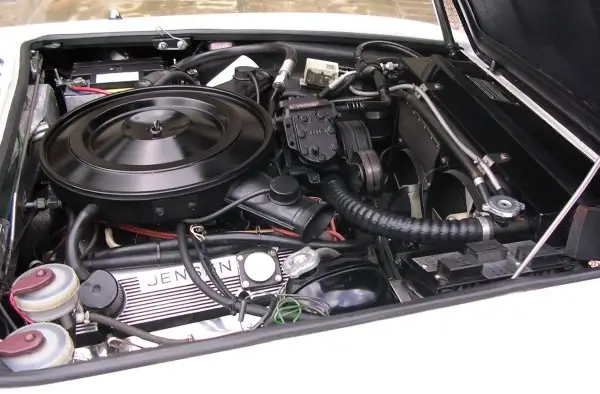
Jensen Interceptor MKIII Engine
The 440 "Six Pack" option was only available on 232 vehicles. The three carburettor option was discontinued in 1972, and the remaining option was detuned to 280 horsepower SAE net. Through 1976, Chrysler offered the 440 c.i. engine with a decreased horsepower output of 255 horsepower SAE net. The Interceptor came standard with features such as electric windows, power steering, reclining front seats, a wood-rimmed steering wheel, a radio, reversing lights, and even an electronic clock.
Jensen Interceptor Tire Pressure & Fitment Guides
1954 Jensen Interceptor Tire Pressures by Michelin (Pg1)
| Model | Tire | Tire Pressure (F/R) PSI |
|---|---|---|
| Interceptor | 6.00 X 16 | 32/32 |
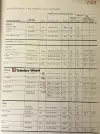
1965-1978 Jensen Interceptor Tire Pressures by Dunlop (Pg1)
| Model | Tire Size | Tire Pressure (F/R) PSI |
|---|---|---|
| 1967-78 Interceptor & Interceptor FF | 185 R15 | 36/40 |
| 1969 Interceptor & Interceptor FF | 185 R15 | 36/40 |
| 1970 Interceptor MKII & MKII FF | ER/70 R15 | 36/40 |
| 1971-1973 Interceptor MKIII, FF, & SP | ER/70 R15 | 36/40 |
| 1974-1976 Interceptor MKIII | 205/70 R15 | 36/40 |
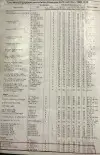
1979 Jensen Interceptor Tire Pressures by Michelin
| Model | TIre | Tire Pressure (F/R) PSI |
|---|---|---|
| Interceptor MkII | 205/70-15 | 36/40 |
| Interceptor MkIII | 205/70-15 215/70-15 |
36/40 32/36 |
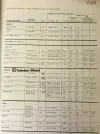
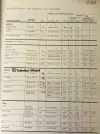
1954-1973 Jensen Interceptor Tire Pressures by Michelin (Pg2)
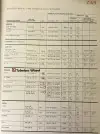
1965-1978 Jensen Interceptor Tire Pressures by Dunlop Pg2
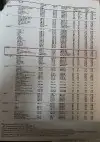
1972 Jensen Interceptor Tire Pressures by Pirelli
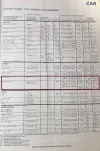
1977 Jensen Interceptor Tire Pressures by Michelin
